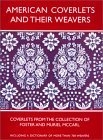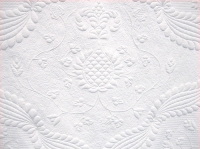-
History of:
- Resources about:
- More:
- Baby walkers
- Bakehouses
- Bed warmers
- Beer, ale mullers
- Besoms, broom-making
- Box, cabinet, and press beds
- Butter crocks, coolers
- Candle snuffers, tallow
- Clothes horses, airers
- Cooking on a peat fire
- Drying grounds
- Enamel cookware
- Fireplaces
- Irons for frills & ruffles
- Knitting sheaths, belts
- Laundry starch
- Log cabin beds
- Lye and chamber-lye
- Mangles
- Marseilles quilts
- Medieval beds
- Rag rugs
- Rushlights, dips & nips
- Straw mattresses
- Sugar cutters - nips & tongs
- Tablecloths
- Tinderboxes
- Washing bats and beetles
- Washing dollies
- List of all articles
Subscribe to RSS feed or get email updates.
...a stuffed quilt which is quite ancient ....... It is a white coverlid drawn in beautiful patterns and stuffed with soft cord, in imitation of the celebrated Marsailles coverlets. From the dates we can gather it is fully a hundred years old.
Letter in a Georgia newspaper, 1890

American Coverlets & Their Weavers
Quilting stitched or woven
Marseilles or Marcella bedspreads, counterpanes, coverlets
 White soft furnishings belong to bedrooms
more than any other part of the house. If you like this look, you'd have appreciated
the Marseilles "quilts", very popular in the 19th century - so well-known that they
turn up regularly in 19th century novels, often described as snowy. One
plausible theory is that they appealed to a Victorian taste for purity.
White soft furnishings belong to bedrooms
more than any other part of the house. If you like this look, you'd have appreciated
the Marseilles "quilts", very popular in the 19th century - so well-known that they
turn up regularly in 19th century novels, often described as snowy. One
plausible theory is that they appealed to a Victorian taste for purity.
Some British and American households changed to white bedroom curtains in summer, as long as they could afford two sets of window "furnishings", and then the white Marseilles counterpanes came out for the season, replacing warmer and darker comforters or eiderdowns.
Summer bed coverings and dressings receive the same attention that are accorded to draperies and furniture for the same season. The Winter spreads are replaced by light dimity, marseilles, or honeycomb, the latter shown now in marseilles patterns, having taken on a new beauty.
New York Times, 1895
These bedspreads were inspired by the beautiful white needlework for which Marseilles and the surrounding region of Provence in southern France are known. The distinctive style involved creating intricate raised patterns by "stuffing" shapes stitched in between two pieces of cotton. Quilts made like this were expensive, scarce, much-admired imports in the English-speaking world.
In the mid-18th century British weavers set to work to reproduce the effect on a loom. Robert Elsden patented his solution in 1763, and is credited with being the inventor of "woven quilting". Different firms developed their own complex layered weaves imitating the textures and patterns of hand sewn Provençal quilting. By the later 19th century, bedspreads like this were widely available at moderate prices. The name morphed, and the bed-covers were also known as Marcella counterpanes or coverlets.*
Extraordinary Sale of
Fine White Quilts.
MARSEILLES PATTERNS, new styles, full size, bought for cash at discount that enables us to offer -
The Dollar quality at 69 cents
The Dollar sixty quality at $1
New York Times, 1893
The fabric was used for other items too: not just other bedroom furnishings, like dressing-table covers, but it was also very fashionable for waistcoats. The design on large bedspreads could be elaborate - with pineapples, bunches of grapes, and flowers sprinkled liberally over the fabric. When sold by the yard, it was more like modern piqué: a firm white fabric with ridged stripes or some other fairly simple pattern.
The Marseilles and Marcella names are still around - not just as a memory kept alive in historic quilt collections in the USA, or in 19th century writing. In England Marcella is the name of a piqué fabric used for stiff evening shirts made by old-fashioned tailors, while in Australia and New Zealand white, or even pastel, covers with self-coloured woven designs are called Marcella bedspreads or quilts. (Sometimes matelassé too, the French for padded.) Meanwhile American quilting experts compare the best old Marseilles bed-covers with work done in the Provençal tradition: boutis, piqué de Marseille, and piqûre de Marseille, or with Italian trapunto, or with other kinds of white-on-white and whole-cloth quilting.
...the piled-up mattresses and pillows of the bed, spread with a snowy Marseilles counterpane.
Charlotte Bronte, Jane Eyre, 1847
There is no clear-cut definition of a Marseilles quilt. As the textile historian, Jacqueline M. Atkins, says, the name "has been applied for more than two centuries, often without clear distinction, to a number of textile categories, from hand-stitched, corded, stuffed, and quilted bed covers made in Provence, France, and elsewhere, to loom-woven Marseilles-style spreads and yard goods made in England, France, and North America." The name may be used for almost any white textured bedspread with a bit of nostalgic charm.
*Other names for the woven "quilting" used in the 19th century were Marseillais, Marseillois, Massilian, Marsella, Mosello, even Mossoul, and also Imperial or French.
...the large white bed with its Marcella quilt, the chill dressing-table, the clean, cold curtains, the polished oilcloth icily gleaming. Mary Webb, Seven for a secret, 1932
See also:
Feather bedding
Cabinet beds
Breton box beds
Medieval beds
 13 June 2007
13 June 2007
You may like our new sister site Home Things Past where you'll find articles about antiques, vintage kitchen stuff, crafts, and other things to do with home life in the past. There's space for comments and discussion too. Please do take a look and add your thoughts. (Comments don't appear instantly.)
For sources please refer to the books page, and/or the excerpts quoted on the pages of this website, and note that many links lead to museum sites. Feel free to ask if you're looking for a specific reference - feedback is always welcome anyway. Unfortunately, it's not possible to help you with queries about prices or valuation.


